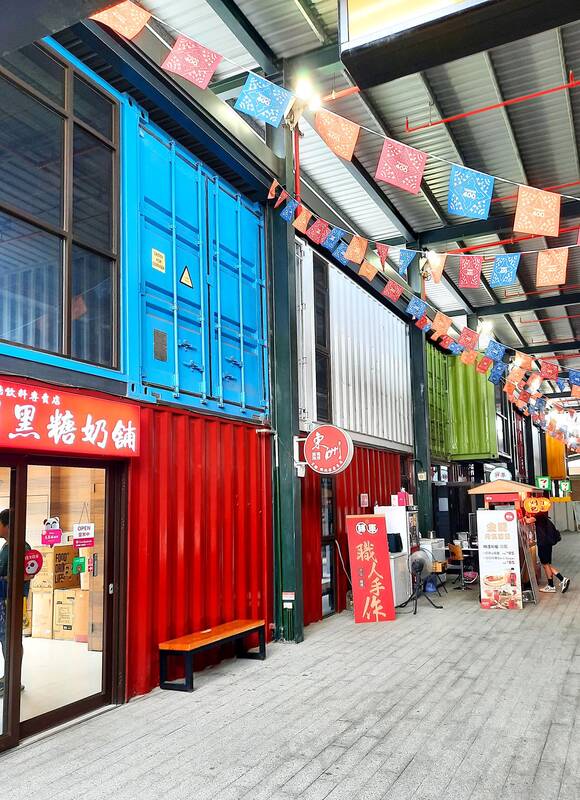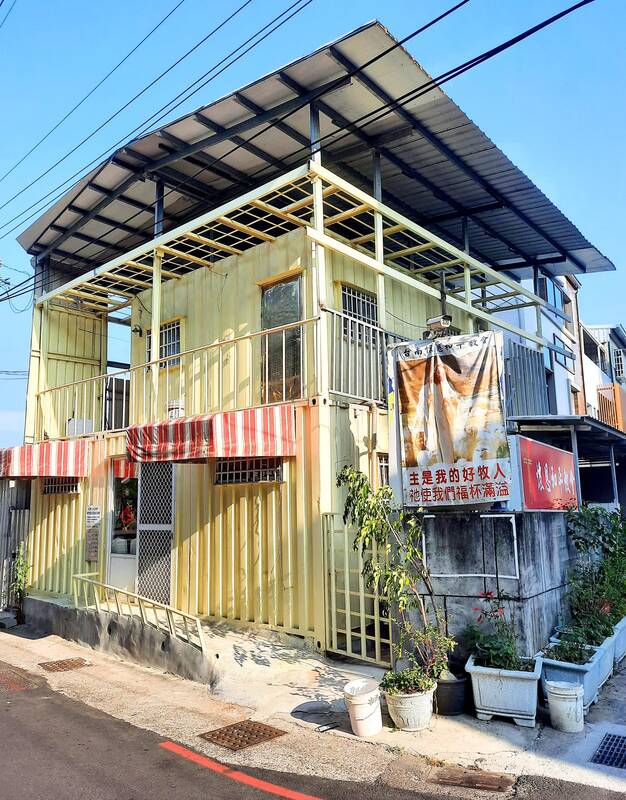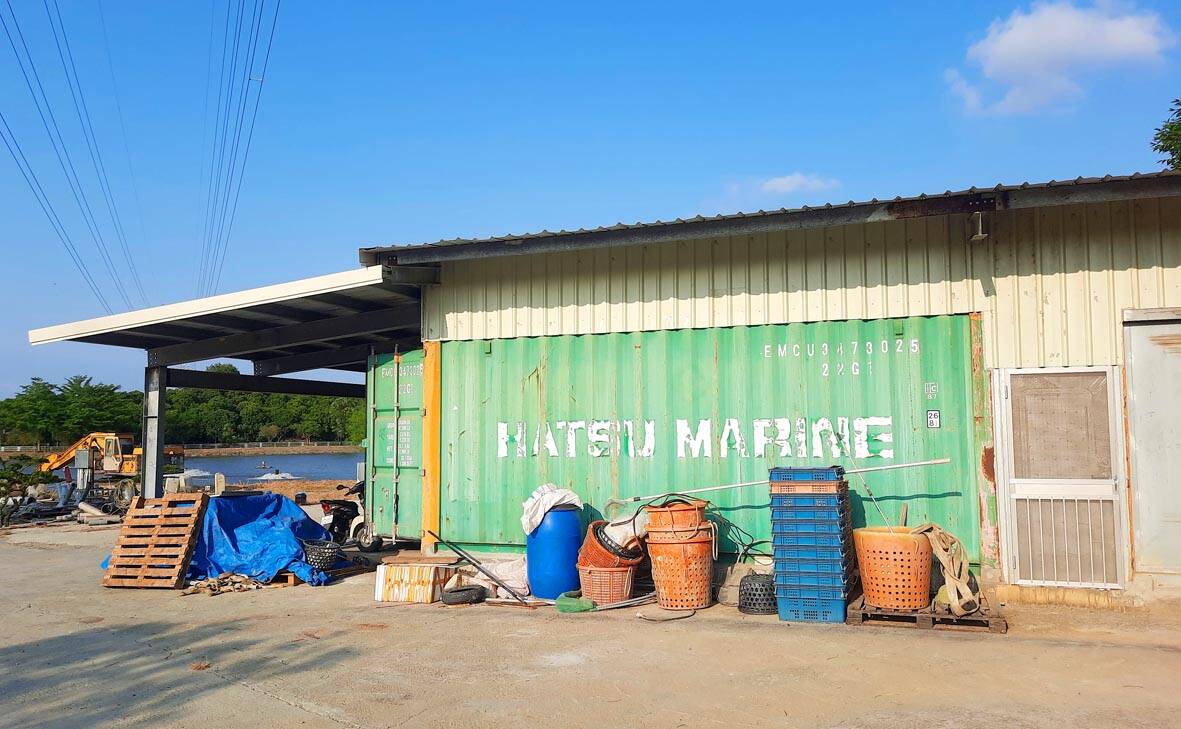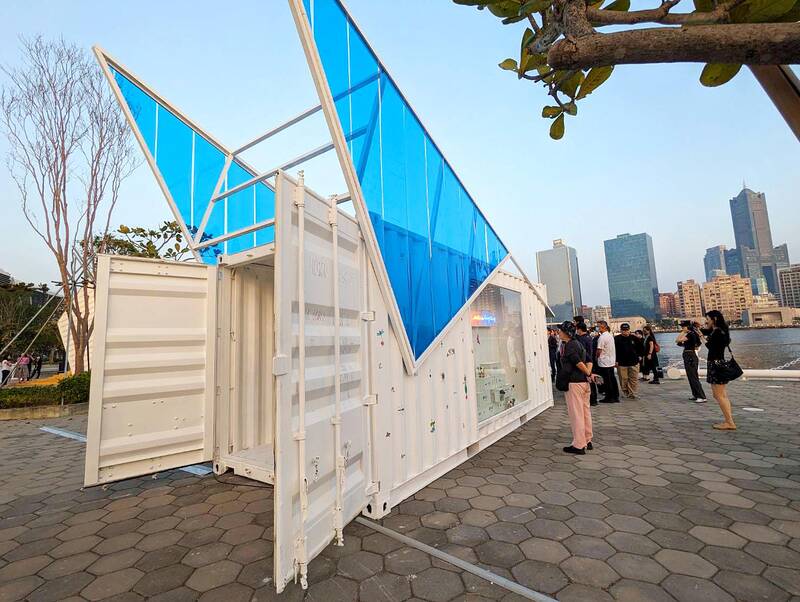Standardized shipping containers arrive in and leave from Taiwan in vast numbers. In 2021, Kaohsiung — the country’s busiest port — handled 9.86 million TEUs (20-foot equivalent units).
Almost all of these rectangular boxes are 6.1 or 12.2m (20 or 40 feet) long, 2.44m (8 feet) wide and either 2.59m (8 feet 6 inches) or 2.9m (9 feet 6 inches) in height. Made of rust-resistant steel, they’re simple yet robust.
Freight companies typically use each intermodal container for 10 to 15 years before retiring it. But they often last much longer, because they’re made to survive the stresses of loading and stacking up to nine high. And it’d have to be a truly hellish gust of wind that could turn one over.

Photo: Steven Crook
Each container has a set of weatherproof swing doors at one end. Once these are locked, the contents are extremely secure, so much so that some business owners in crime-ridden neighborhoods in Africa and Central America think operating out of a cargo container beats renting a conventional storefront. By one estimate, more containers are currently used for non-shipping purposes, such as static storage, than for transporting goods.
SUSTAINABLE ARCHITECTURE
Advocates of sustainable architecture are drawn to intermodal containers because they offer an alternative to conventional energy-intensive methods of building. Compared to a brick structure of identical dimensions, using a shipping container saves between 20 percent and 43.3 percent in embodied energy (depending on the age of the box) and lowers construction-related carbon dioxide emissions by up to 49.3 percent, according to a 2021 study by Ugandan researchers.

Photo: Steven Crook
What’s more — and this is highly relevant to Taiwan, where unused buildings litter the landscape — they’re easy to move or remove if no longer needed. When container houses are scrapped, recycling the steel is more efficient and straightforward than crushing and reusing the rubble that’s left over when a reinforced concrete (RC) structure is demolished.
The price of secondhand containers varies hugely. Last month, a weathered 6.1 meter box in Kaohsiung was advertised on social media for just NT$20,000. A few weeks earlier, a company that specializes in what’s been dubbed “cargotecture” was asking NT$138,000 for one of the same size that had been repainted, refloored and fitted with large windows and a side door. For an additional NT$7,000, they were willing to deliver it to the other end of the island.
The Web site of Asperworld Log & Timber Homes, a Taichung-based builder of wooden houses, acknowledges the advantages of cargotecture for those with a limited budget, but claims there are “inherent shortcomings that can’t be overcome.”

Photo: Steven Crook
Issues like poor insulation and a lack of air circulation, the Web site says, “can indirectly lead to greater energy consumption and higher electricity bills.”
The need for ventilation is why windows are usually cut into the sides of containers being repurposed as shops or offices. Another solution is to stack one box on top of another and remove the top of the lower container and the floor of the upper one; this was done by the designers of Tainan Bus Station, so as to create high-ceilinged waiting areas where decent ventilation reduces the need for air conditioning.
In Taiwan’s climate, metal boxes quickly soak up heat. Rather than add a layer of insulation, which would reduce the space available inside, many cargotects prefer to add a metal awning so the container isn’t exposed to direct sunshine.

Photo: Huang Chia-lin, Taipei Times
Installing photovoltaic panels, to produce electricity and block the sun, would seem to be an obvious solution. But this isn’t always possible, because Taipower won’t sign a feed-in-tariff contract if the array is sited on an unlicensed extension or an illegal structure.
Another heat-control option is to plant a rooftop garden (see “Why you should turn your roof into a leafy paradise” in the Oct. 13, 2021 issue of this newspaper).
PROS AND CONS
Throughout Taiwan, old containers have been repurposed as betel nut stands, storage sheds and even cozy rural retreats.
Some of them still bear the original owner’s color scheme and logo. This is alarming, because the paints shippers used in the past often contained lead or chromates. The poisonous qualities of the former are well known; the latter are carcinogenic and allergenic.
Containers usually have a hardwood floor that’s been saturated with preservatives to stop rotting and strong pesticides to prevent infestations of insects and vermin.
Many say that, if the box’s dry-land function is going to be anything other than storage, for the sake of human health the new owner must tear out the wood and sandblast every square centimeter of painted surface. This isn’t only an expensive and unpleasant job, but it also generates toxic waste, sometimes over 700 kg per TEU.
Others, among them Texas-based cargotects Falcon Structures, advise against sandblasting, and not just to save money. Sandblasting strips off both high-quality ocean-grade paint and the container’s anti-rust zinc coating. Instead, those who plan to use a container as a home or a workplace should prime and paint over the existing marine paint. This approach is endorsed by Mark Lin (林志峰), a Kaohsiung-based cargotect who heads up an eponymous architectural studio.
While emphasizing that each project is unique, Lin says that a container building is often 20 to 30 percent cheaper than a conventional RC structure. If there’s good coordination between everyone involved, construction time may be just half that needed for an RC building, he adds.
In addition to functional structures such as restaurants and office buildings, Lin’s firm has also used shipping containers to realize award-winning pieces of public art.
POPULAR AND CONTROVERSIAL
One of Taiwan’s most-photographed cargotecture projects is a Starbucks branch in Hualien County’s Jian Township (吉安) that consists of 29 heavily modified intermodal containers.
Tainan Bus Station was shortlisted for an award at the 2019 World Architecture Festival, yet some locals asked if their city is so cash-strapped it had to build its new station out of old shipping containers. In fact, the use of recycled materials is just one advantage of that particular design. The authorities sought a lightweight structure with shallow foundations, because the plot served an arsenal from the early 1800s until a few decades ago, and deep excavations would likely have damaged an uninvestigated historical site.
Container buildings aren’t necessarily cheap. TTstyle, a creative-industries hub in Taitung City, cost NT$102.89 million when it was completed in 2016. But its eye-catching appearance surely helps attract shoppers and tourists.
Fans of modular construction say modern techniques have similar advantages to container structures in terms of speedy building and relocatability, but fewer disadvantages. Lightweight prefabricated walls and roofs save energy, for sure — but might not look sturdy enough to win over people who live in East Asia’s typhoon zone.
According to an Aug. 28 report last year in the Liberty Times (sister newspaper of the Taipei Times), the Kaohsiung City Government has been considering adding modular bathrooms to some of the municipality’s parks. While they’d be less expensive than cargo-container bathrooms — both would be far cheaper than RC facilities — the newspaper reported that the city’s Public Works Bureau was inclined to recommend “container-type public toilets, because they’re heavier and won’t blow away in a typhoon.”
Steven Crook, the author or co-author of four books about Taiwan, has been following environmental issues since he arrived in the country in 1991. He drives a hybrid and carries his own chopsticks. The views expressed here are his own.

As I finally slid into the warm embrace of the hot, clifftop pool, it was a serene moment of reflection. The sound of the river reflected off the cave walls, the white of our camping lights reflected off the dark, shimmering surface of the water, and I reflected on how fortunate I was to be here. After all, the beautiful walk through narrow canyons that had brought us here had been inaccessible for five years — and will be again soon. The day had started at the Huisun Forest Area (惠蓀林場), at the end of Nantou County Route 80, north and east

Specialty sandwiches loaded with the contents of an entire charcuterie board, overflowing with sauces, creams and all manner of creative add-ons, is perhaps one of the biggest global food trends of this year. From London to New York, lines form down the block for mortadella, burrata, pistachio and more stuffed between slices of fresh sourdough, rye or focaccia. To try the trend in Taipei, Munchies Mafia is for sure the spot — could this be the best sandwich in town? Carlos from Spain and Sergio from Mexico opened this spot just seven months ago. The two met working in the

Exceptions to the rule are sometimes revealing. For a brief few years, there was an emerging ideological split between the Democratic Progressive Party (DPP) and Chinese Nationalist Party (KMT) that appeared to be pushing the DPP in a direction that would be considered more liberal, and the KMT more conservative. In the previous column, “The KMT-DPP’s bureaucrat-led developmental state” (Dec. 11, page 12), we examined how Taiwan’s democratic system developed, and how both the two main parties largely accepted a similar consensus on how Taiwan should be run domestically and did not split along the left-right lines more familiar in

A six-episode, behind-the-scenes Disney+ docuseries about Taylor Swift’s Eras Tour and Rian Johnson’s third Knives Out movie, Wake Up Dead Man, are some of the new television, films, music and games headed to a device near you. Also among the streaming offerings worth your time this week: Chip and Joanna Gaines take on a big job revamping a small home in the mountains of Colorado, video gamers can skateboard through hell in Sam Eng’s Skate Story and Rob Reiner gets the band back together for Spinal Tap II: The End Continues. MOVIES ■ Rian Johnson’s third Knives Out movie, Wake Up Dead Man